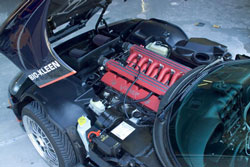Engine Cleaning - Engine Care
Automotive Detailing
Step 1 - Engine Degreasing
 Help prevent rust, provide leak detection, belt wear detection and make your engine look great with regular engine cleaning and engine care. Engine cleaning should be the 1st step in your auto detailing process: you'll need to rinse away engine grease and you don't want to risk water spots or grease debris on a freshly washed car. Help prevent rust, provide leak detection, belt wear detection and make your engine look great with regular engine cleaning and engine care. Engine cleaning should be the 1st step in your auto detailing process: you'll need to rinse away engine grease and you don't want to risk water spots or grease debris on a freshly washed car.
First, to soften engine grease, start the vehicle's engine, let it warm up for a few minutes and shut it off. If needed cover areas susceptible to water damage (air intake, distributor, coil and oil dipstick are the main concerns). For proper engine care be sure to check the tightness of all automotive engine compartment caps then cover with some type of plastic and tighten with rubber bands.
Spray engine degreasing product over entire engine and allow dwelling time of about 3-5 minutes. Use a microfiber towel, a cleaning brush or a 100% cotton towel to gently agitate the heavily soiled areas. Re-apply as needed. Rinse thoroughly, but remember, the stronger the spray, the more vulnerable your water sensitive parts; dry any access water and moisture.
Remove protective coverings and start the engine allowing it to warm up. This will dry the rest of the engine and evaporate any moisture that may have collected in the sensitive components. Once the engine is clean, dry and has completely cooled, you may wish to apply a coating of protectant to any rubber or plastic shields.
If the uncoated aluminum areas are dull or have whitish corrosion, using a metal polish will restore the finish and make them shine. It is also a good idea to check the battery terminals, to guarantee that they are clean. If not, disconnect the cables and clean both the cable terminals and battery posts with a wire brush.
Automotive Detailing; Step 2: Cleaning Wheels, Tires and Rims
|
Back to DIY Guide | How To Cleaning and Detailing Tutorials